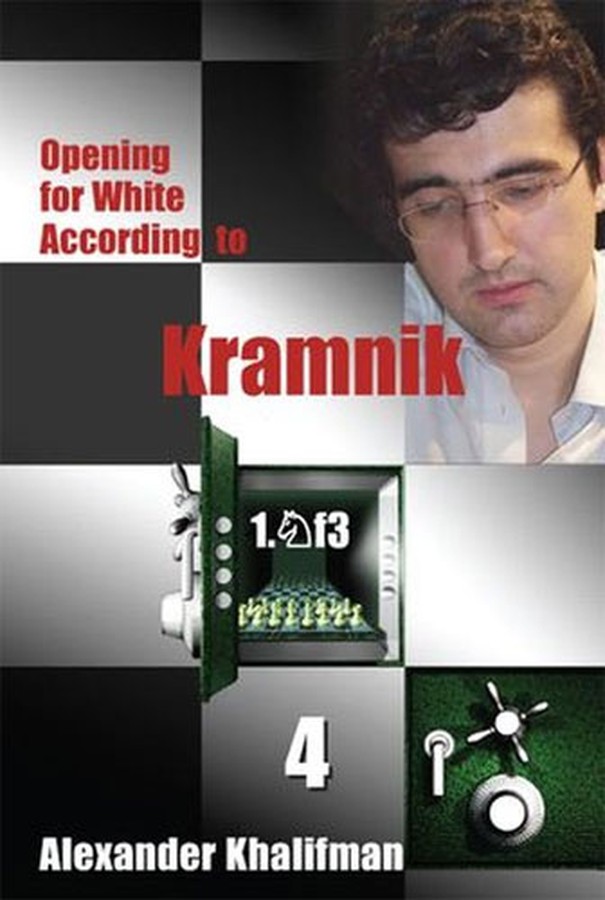| Nivå | C-D |
| Utgivelsesdato | Januar 2011 |
| Forfatter | |
| Pris | 235 NOK |
Opening for White according to Kramnik 4
En betydelig utvidet "Kramnik 4" i den seriøse og skikkelige repertoarserien til "team Khalifman" i St. Petersburg. Her tre åpninger som oftere oppstår etter andre førstetrekk, men smarte overganger er noe av finessen med disse bøkene.
Dette er noen av markedets grundigste åpningsbøker, og hvert kapittel har en fin oppsummering av blant annet hva han mener hvit kan oppnå av teoretisk og praktisk fordel, press og initiativ. Utgangspunktet er altså repertoarvalg fra Vladimir Kramnik, en annen russisk eks-verdensmester i dag, i utgangspunktet på 90-tallet da serien startet opp med førsteutgaver av disse populære åpningsbøkene for ambisiøse spillere.
Noen synes nok at evalueringen av endel varianter er i meste laget positiv for hvit, men det ligger vel litt i kortene for en repertoarbok. Så kan det blant annet være nyttig for svartspillere i disse åpningene å vite hva som blir anbefalt fra den andre siden!
INNHOLDET I BOKA:
- Part 1. The Maroczy System 1.Nf3 c5 2.c4 g6 3.e4
- Part 2. The Modern Defence 1.Nf3 g6 2.e4
- Part 3. The Trifunovic System 1.Nf3 d6 2.d4
KHALIFMANS FORORD TIL BOKA:
Dear readers,
We have analyzed in volume 4 of our series “Opening for White According to Kramnik” several opening systems, which begin with different moves, but they have something in common. In the majority of the variations that we study, Black chooses dark-squared strategy. This is connected most often with a fianchetto of his king’s bishop. Despite the fact that neither of these systems has been a frequent guest at the top-level tournaments, the majority of the variations have the reputation of “a hard nut to crack”. White cannot obtain a meaningful advantage by playing just common sense chess.
In the first part of this volume we analyze the Maroczy system. It arises sometimes via the King’s Indian Defence, or the Sicilian Defence and has the reputation of a solid, but rather passive opening for more than a century. It is not so popular at top-level lately mostly due to its passivity. It has many more adherents at somewhat lower levels, though. One of the pluses of this opening set-up is that Black can choose it against different first moves for White (including 1.е4) and this facilitates considerably the preparation of his opening repertoire. Therefore, I believe this book may be quite useful not only for the players who begin their games with 1.Nf3. In principle, maintaining a slight opening edge with White in the Maroczy system is not a super-difficult task at all, since he has right from the beginning of the game a powerful pawn-centre and a stable space advantage. Still, it often happens that he keeps this edge during the entire game, but at the end it all ends in a draw. Accordingly, we emphasize in this part on the realisation of the standard plans of development and their connection with the subsequent middle game and even the endgame.
The second part of this volume is devoted to the variations arising after 1.Nf3 g6 2.e4, or the Modern Defence. A more appropriate name for it has not been invented yet and we have not contributed to this either. Black’s first move 1...g6 has acquired recently immense popularity even at the top-level as a specific “anti-anti Gruenfeld”. I will try to explain this to you. Black is ready to play the Gruenfeld Defence after 2.d4, but wishes to avoid the “anti-Gruenfeld” set-ups analyzed in the first volume of this series. White’s attempts to transpose to them (or to the King’s Indian Defence) with the move 2.с4, can be countered by Black with the rather unpleasant resource 2...Bg7 3.e4 e5! and there arises an “irregular” version of the King’s Indian Defence, with a black pawn on d7, in which White has no chances of obtaining an advantage, at least according to contemporary theory Therefore, if he wishes to avoid entering the Gruenfeld Defence, just like before, but wishes to fight for the opening advantage, White practically has no other choice but - 2.e4! This should not bother him so much. He will not be forced to enter open games, since Black has reduced considerably his choice with his first move. After 2...с5, White will play the Maroczy system and if Black develops his pieces in the spirit of the King’s Indian Defence (d6+Bg7), then I recommend to White a very specific set-up, connected with the development of the bishop on d3 and fortifying of the pawn-centre with the move с2-с3. This system may not be the most aggressive, but leads to a solid positional game, much more typical for the closed openings. I am convinced that White maintains superior prospects in all the variations.
Finally, in the third part of the book, we have analyzed set-ups beginning with the moves 1.Nf3 d6. After them, there arise original positions only in the variation 2.d4 Bg4. This opening system reached the peak of its popularity during the 80ies of the past century, but then it became evident that it did not provide Black with any pluses except its originality. If White plays correctly, in the majority of the cases he obtains a pair of bishops in addition to his space advantage. The utilization of two bishops is one of the favourite strategical resources of Vladimir Kramnik, so for players who are well familiar with his games it will be easy and enjoyable to play similar positions with White.
A.Khalifman, 14th World Chess Champion
| Innbundet? | Nei |
| Type | Bok |
| Språk | Engelsk |
| Antall sider | 396 |
Produktet er en del av serien Opening for White according to Kramnik
En faglig seriøs og grundig bokserie som bygger et åpningsrepertoar for hvit med åpningstrekket 1 Sf3, men der hvit i de fleste tilfeller vil følge opp med et senere både d4 og c4. Serien presenteres som "Kramniks åpningsrepertoar", som i hovedsak er riktig, men selvfølgelig ikke må tas for bokstavelig. Dette er først og fremst detaljerte forslag fra tidligere FIDE-verdensmester Aleksander Khalifman og hans team i St. Petersbrurg til hvordan hvit kan spille for en seriøs fordel i åpningen gjennom kritisk krevende varianter for svart å besvare. Førsteutgaven til serien utkom rundt århundreskiftet, men er nå utsolgt. Foreløpig foreligger nå fire bøker i den ganske sterkt utvidede 2.utgaven av denne bokserien.
Se også
-

Opening for White according to Kramnik 3 1.Sf3
KjøpDenne nyutgaven av tredje bind i den kyndige serien som følger "Kramniks åpningsrepertoar med 1 Sf3" har blitt en grundig spesialbok sett fra hvits side om Symmetrisk engelsk etter 1 Sf3 c5 2 c4.
- Pris
- 240
- Nivå
- C-D
- Av
- Utgivelsesdato
- Mai 2011

